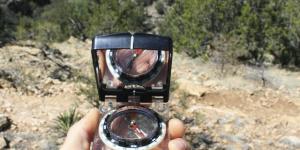How to Keep Safe if you Go Walking in the Mountains


Going for a hike or walk in the mountains is a great way to reconnect with nature, step outside of our busy lives and gain some perspective while enjoying the view. It can be a personally rewarding as well as enjoyable way to spend the weekend. All this perspective will come to nothing if you don't be considerate of the often precarious environment a mountain walk can be. Even if a calm day and the conditions seem perfect, there are many potential dangers while walking in the mountains. At oneHOWTO we don't want to discourage you. Knowing how to keep safe if you go walking in the mountains means you can share memories of your adventure by keeping you safe and respecting the inspiring awe of rocky nature.
Steps to follow:
Plan your hike
Going for a walk in the mountains has many different incarnations. You may want to go for a leisurely stroll up some easily accessible hills or bring out the climbing gear and tackle some steep slopes. Either way, good planning can mean the difference between an invigorating afternoon and a disaster. Check out your route. If your hike is in a national park or somewhere well known for hiking, then it is likely you are walking where others have gone before. They will have special routes and often signposted areas. Check routes, mark them on your map and have a contingency plan if there is some reason your chosen route is unavailable.
Part of your planning will be to gauge the environment. Another is to gauge yourself and your party. Know your fitness levels and set realistic targets for yourselves. Just because you are eager and raring to go, doesn't mean everyone in your group is on the same page. If someone says they are not feeling well or need to pace themselves, pushing them too hard can be counterproductive. Knowledge of and experience on the mountains are important, especially on rockier terrain, so trust them. If this means going with a guide, it won't take away from your day. That is unless your ego is more important than your safety.
Before you leave, if you find that the weather has got worse, or if you are not feeling healthy that day, then you may select an easier route. You may even want to plan for some other day. Experience will help you gauge the risk, but caution is important. If the weather suddenly changes during the trek, then don’t feel ashamed to return back.

Bring the right equipment
The right equipment is known thanks to good planning. Although going out for a hike is different in summer than it is in winter, there are similar considerations. One of the most important is your shoes. Hiking boots do not only keep you comfortable, they can keep you safe. A solid sole will help you over crags and rocks. If there is a chance of rain or you need to cross water, then keeping them as dry as possible will be important. If not, you might be at risk of damp feet which can even lead to pneumonia in extreme cases. Your boots should be appropriate for the terrain at hand.
A light walking shoe might be good for a short hike, but if you will be walking over a lot of uneven ground, you may need a boot. This is because boots will help keep your ankle supported when going for a walk on the mountain. If you want to stay safe while hiking, your boots shouldn't be too tight or too loose. A loose boot can lead to abrasions on your feet. Even small ones can be hazardous and certainly be uncomfortable. Socks are also important to stay safe when walking in the mountains.
As you move up a mountain, the winds may become stronger and nights colder. Even if it is summer time and the weather is fine at sea level, snow or rain may appear suddenly out of nowhere. It is a good idea to bring along a waterproof jacket or fleece with you, regardless of the weather. You would rather have one and not need it, than need one and not have it.
If you are on a serious hike, then you should bring a means of communicating with people on the ground. Bringing a mobile phone will be useful, but only within range. If you are going on a long hike, a satellite phone or some other way of communicating might be necessary. You should not only plan for what you expect, but also the unexpected. You might be used to Google Maps finding your way to the nearest supermarket, but this might not be as useful on a mountain. A good ole fashioned compass and map might be your best bet to stay safe.

Hydration is key
Perhaps the most important thing you need to bring if you want to stay safe on the mountains, is water. Bring loads of water on your trek. Intense heat and sun, together with mountain climbing, may lead to dehydration. You can feel hot and thirsty even during the winter. Experts advise not to drink from a river, unless you have someone in your group who knows the source. Water purifying tablets can be helpful, especially in emergencies.
Energy levels are important when walking on a mountain, especially if you find yourself in trouble. You should bring some high energy food which is concentrated and can be stored easily. This means if you do get lost, you might be able to power through. Bringing too much can weigh you down, so just bring the necessities.

Staying safe in the sun
The sun will light up your view and help with some really good pictures. However, it can also work against you when walking in the mountains if you're not careful. Even in winter, the sun can be strong and cause sunburn and sunstroke. Sunburns are more of a concern in the long term as it can damage your skin. However, sunstroke can deplete your energy levels drastically and might mean you can't get back even with relatively little to go. Even if you feel determined, your body will start to tell you if you are getting too hot. It is better to turn around than persevere and pay the price.
Keep your head covered and apply sunscreen. Sun is going to be stronger at heights, so you have to be extra careful while going high up in the mountains. Sunglasses will also be useful as sun can damage your eyes and make it difficult to say safe. This is especially so in the winter snow. The sun will be lower in the sky, but still strong. It will also reflect off the white snow, which is why many skiers can be seen with lots of sunscreen on their noses.

Don't go it alone
Inform your family and friends about where you are going. Whether hiking on your own or in a group, you want to be in contact with people. Give the map of your route to someone and follow it strictly. Also tell them how long you are going to do trekking. If you do not return back by a specific date, the friend should become alert and take necessary steps. Time is of the essence in an emergency, so if you fall or get lost, rescue services will find yoou more easily and can provide treatment if they known exactly where you'll be.
If you are in doubt, ask for expert advice. Collect up to date weather conditions about the mountain and plan accordingly.
Be careful of wildlife
Staying safe while walking in the mountains is also about being vigilant. While the environment and your own physicality need to be considered, so to do the animals which share this environment. Keep an eye out for signs of bear warnings or other dangerous creatures. This should be part of your planning. Known what to look for and how to deal with them if you encounter them. Don't approach wild animals and be careful if you are eating food not to leave it out and attract them. If you see signs of wild animals, particularly if there is a den or nest, then you might want to reroute your walk. This is another reason why alternative and backup routes at the planning stage can be so helpful on a hike.
Large animals might be more noticeable, but you should also be careful of insects like ticks. These can latch on to your skin and even cause infection. Wearing longer protective pants in areas with a lot of ticks is advised.

First aid on the mountain
Anyone who has seen 127 Hours will know that a fall can lead to disaster. This could be the case if a big rock crushes your hand, but even minor scrapes and cuts can be more dangerous on the mountainside. A nick or gash could lead to excessive bleeding. Blood infections like septicaemia can also occur if you cut yourself on something dirty. Bringing a basic first aid kid is a minimum, but you or someone in the party should also know how to use it.
Bringing a pen knife or simple universal tool can also be extremely useful. Not just for practical things like opening food containers or getting mud of your boots, but for trimming bandages or the like.
Staying safe while going for a walk or hike in the mountains is something you need to consider. But once you have thought of all the possibilities and come prepared, it means you can get on with enjoying your trek into nature.
If you want to read similar articles to How to Keep Safe if you Go Walking in the Mountains, we recommend you visit our Recreational activities category.








